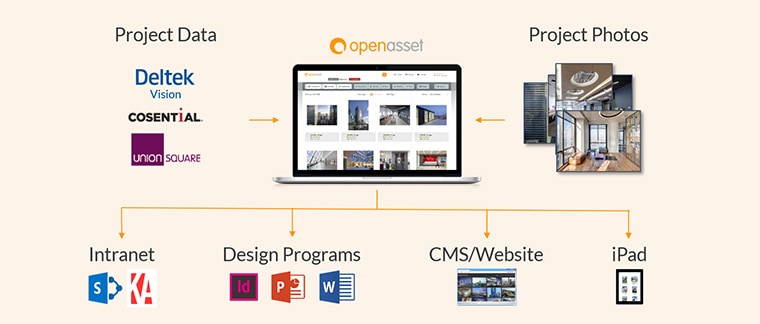How to Improve Brand Consistency
Apr 14, 2022

Five Ways to Create and Maintain a Consistent Brand Experience
As your business grows, so will your marketing efforts and the number of brand and media assets that you use to create ads, write proposals, and engage with your audience on social media. This AEC marketer’s guide has everything you need to make sense of your disparate digital assets, and provide a brand identity that is on message and visually consistent on every channel.
What is Brand Consistency and Why is it Important
Brand consistency refers to a company’s ability to maintain its identity, values, and strategy over time. Brand consistency is important because it enables your marketing and sales teams to:
- deliver messaging that aligns with the company’s stated values,
- foster trust and confidence in your business,
- shape brand perception
- evoke positive emotions
- differentiate your brand from the competition, and
- promote the visual brand elements (logos, colors, etc,) that make your brand recognizable.
How to Improve Brand Consistency Across Marketing Channels
The best way to improve brand consistency is to take stock of the plethora of different elements that make up your brand. Though the idea of rebranding your business at this juncture sounds exciting, the goal of this exercise is to root out inconsistency across your marketing channels, including:
- Website,
- Social Media Platforms,
- Digital Ads,
- Physical Advertisements, and
- Signage.
If you get bored looking at the same visual elements and reading the same messaging over and over again, then your brand is consistent and likely to generate brand recognition. If you notice that visual elements of your brand differ from channel to channel, or that your tone on Twitter sounds different than your tone on Facebook, then efforts to improve brand consistency are likely needed. Fortunately, there are five things you can do right now to establish and maintain consistent branding across your marketing channels.
Develop Brand Guidelines
The first step to improving brand consistency is to develop brand guidelines that impose clear rules and standards for your visual and written materials. Any conversations that arise regarding your visual elements and messaging will serve as the foundation for your brand guidelines.
In other words, to improve brand consistency you first have to sit down with your marketing team to discuss your future branding efforts and reach a consensus on the various elements of your brand, such as:
- Voice and Tone – The voice and tone of your brand should encapsulate the key traits of your business in a way that is immediately perceptible to your audience. It should flow naturally and present the same image of your business on every channel that you occupy. A hair salon for kids, for example, needs a fun and approachable vibe, while an architectural firm should adopt a more serious and dependable tone.
- Color Palette/Scheme – The color palette of your brand should be consistent but not monotonous. Pick a dominant color and 3 – 4 complementary tones for a secondary palette. Remember that uniformity of colors will strengthen brand recognition.
- Logo Design – In addition to a uniform logo design, you should also set rules for how the logo is displayed in different formats. Be sure to include any color variations and guidelines for vertical and horizontal formatting.
- Images, Videos, and Digital Assets – Provide guidance on the type of stock or proprietary photography and illustrations to be used in your branding and marketing efforts. Consider what’s appropriate for your brand—for example, maybe images of products should be fresh and modern, while other businesses might do well with a vintage look. If you’re including images of people, make sure they represent your target audience so potential customers identify with what they see.
- Fonts and Typography – Brands typically utilize a primary font and a secondary typeface that are variously used for titles, paragraph text, or captions. Much like your color palette, the uniformity of a limited rotation of fonts will help increase your brand’s recognizability.
- Copy and Content – The words you choose and how you use them say a lot about who your brand is. Punctuation and other copy guidelines will also help maintain a consistent message.
- Frequency – To Identify where you may be under or over-communicating, it’s best to consider how often you send emails, post to social media, conduct direct mail outreach, or implement any other aspect of your multi-channel plan.
Plan Ahead with a Marketing Calendar
Though it takes forethought, planning, and effort, one of the best ways to improve brand consistency is to map out your branding efforts and advertising campaigns with a marketing calendar. The advanced planning provides enough time to tweak your messaging for consistency if necessary. A marketing calendar also enables your team to:
- Coordinate multi-channel campaigns – A marketing calendar provides your team with a place to view and monitor the execution and consistency of branding and advertising campaigns.
- Schedule email campaigns and social media ads in advance – By planning ahead, you provide your team with breathing room to make changes and adjust the timing of promotions as needed.
- Review past campaign performance – A marketing calendar enables your team with a record of past campaigns to which you can compare the performance and consistency of your branding efforts.
Create Evergreen Content (Repurpose Old Content)
Evergreen content is content that is consistently relevant and reusable. The more evergreen content that you create, the easier it is to provide a consistent brand experience. Fortunately, the opportunities to reuse and repurpose existing content are as numerous as you are creative.
- Data from a survey report can be used to create an infographic.
- Sound bites from webinars can be edited down into 1- or 2-minute clips that are perfect for social media.
- “How to” articles can be updated with new examples and reposted with a new headline.
- Blog posts highlighting customer success stories could be compiled into an e-book.
- A presentation for prospective clients could be turned into a shareable slide deck showcasing your range of services.
Standardize the Approval Process
As with any business initiative, the easiest way to improve consistency is to implement a standardized approval process for all branding and marketing materials. By doing so, you guarantee that a process is in place to catch inconsistencies before it is too late.
Implement a DAM to Organize Marketing and Branding Assets
There are many ways to improve the consistency of your brand, but all of them require a substantial amount of time and effort on behalf of your marketing team. Fortunately, there are tools available that make the process easier.
Digital asset management (DAM) is a business process and information management technology that enables organizations with a centralized system to organize and access their media assets. Armed with the power of self-service, your sales, marketing, and communications teams can collaborate more effectively; locate the assets they need, and capitalize on opportunities without unnecessary downtime.
By implementing a modern DAM system, like OpenAsset, you also enable your team with the capabilities they need to deliver a consistent brand message and support omnichannel customer experiences at scale without the extra time and effort.
How to Maintain Brand Consistency Indefinitely
When it comes to your brand, the best way to ensure consistency is to implement a software solution to manage the ever-growing number of images, videos, logos, and media you keep in your digital asset library. One such solution is OpenAsset, the only Digital Asset Management (DAM) software designed specifically for firms in the built world. Follow the link to learn more or to schedule a demo today.





